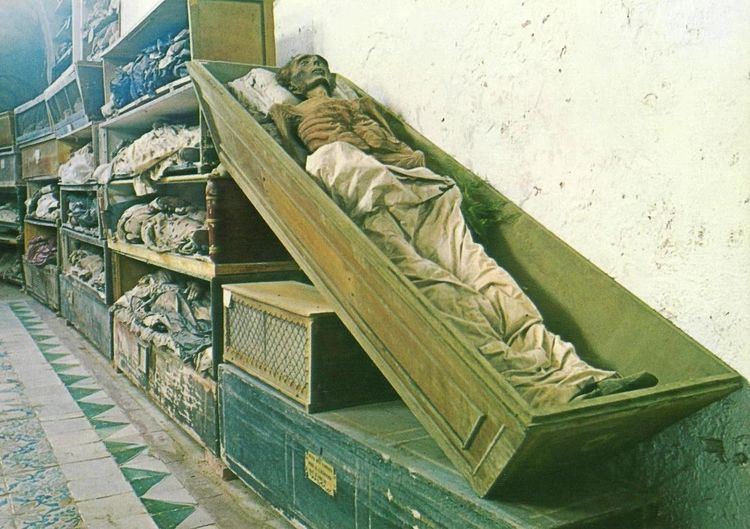Phone +39 091 652 7389 | ||
 | ||
Hours Open today · 9AM–1PM, 3–6PMMonday9AM–1PM, 3–6PMTuesday9AM–1PM, 3–6PMWednesday9AM–1PM, 3–6PMThursday9AM–1PM, 3–6PMFriday9AM–1PM, 3–6PMSaturday9AM–1PM, 3–6PMSunday9AM–1PM, 3–6PM Similar Martorana, Quattro Canti, Palazzo dei Normanni, Church of the Gesù - Palermo, Palermo Cathedral | ||
Nodnarb catacombe dei cappuccini
The Capuchin Catacombs of Palermo (also Catacombe dei Cappuccini or Catacombs of the Capuchins) are burial catacombs in Palermo, Sicily, southern Italy. Today they provide a somewhat macabre tourist attraction as well as an extraordinary historical record.
Contents
- Nodnarb catacombe dei cappuccini
- Palermo catacombe dei cappuccini
- Historical background
- Interments
- Tourism
- References
Palermo catacombe dei cappuccini
Historical background
Palermo's Capuchin monastery outgrew its original cemetery in the 16th century and monks began to excavate crypts below it. In 1599 they mummified one of their number, recently dead brother Silvestro of Gubbio, and placed him into the catacombs.
The bodies were dehydrated on the racks of ceramic pipes in the catacombs and sometimes later washed with vinegar. Some of the bodies were embalmed and others enclosed in sealed glass cabinets. Monks were preserved with their everyday clothing and sometimes with ropes they had worn as a penance.
Originally the catacombs were intended only for the dead friars. However, in the following centuries it became a status symbol to be entombed into the Capuchin catacombs. In their wills, local luminaries would ask to be preserved in certain clothes, or even to have their clothes changed at regular intervals. Priests wore their clerical vestments, others were clothed according to the contemporary fashion. Relatives would visit to pray for the deceased and also to maintain the body in presentable condition.
The catacombs were maintained through the donations of the relatives of the deceased. Each new body was placed in a temporary niche and later placed into a more permanent place. As long as the contributions continued, the body remained in its proper place but when the relatives did not send money any more, the body was put aside on a shelf until they resumed payment.
Interments
The last friar interred into the catacombs was Brother Riccardo in 1871 but other famous people were still interred. The catacombs were officially closed in 1880 but tourists continued to visit. The last burials are from the 1920s. One of the very last to be interred was Rosalia Lombardo, then nearly two years old, whose body is still remarkably intact, preserved with a procedure that was lost for decades, but was recently rediscovered. The embalming procedure, performed by Professor Alfredo Salafia, consisted of formalin to kill bacteria, alcohol to dry the body, glycerin to keep her from overdrying, salicylic acid to kill fungi, and the most important ingredient, zinc salts (zinc sulfate and zinc chloride) to give the body rigidity. The formula is 1 part glycerin, 1 part formalin saturated with both zinc sulfate and chloride, and 1 part of an alcohol solution saturated with salicylic acid.
The catacombs contain about 8000 corpses and 1252 mummies (as stated by last census made by EURAC in 2011) that line the walls. The halls are divided into categories: Men, Women, Virgins, Children, Priests, Monks, and Professionals. Some bodies are better preserved than others. Some are set in poses; for example, two children are sitting together in a rocking chair. The coffins were accessible to the families of the deceased so that on certain days the family could hold their hands and they could "join" their family in prayer.
Famous people buried in the catacombs include:
Tourism
The catacombs are open to the public and taking photographs inside is supposedly prohibited. However, the bodies have been shown on film in Francesco Rosi's "Cadaveri Eccellenti" ["Illustrious Corpses"}, and television programmes such as the Channel 4 series Coach Trip, BBC TV series Francesco's Italy: Top to Toe, Ghosthunting With Paul O'Grady and Friends on ITV2 in 2008 and The Learning Channel in 2000. Iron grills have been installed to prevent tourists tampering or posing with the corpses.
